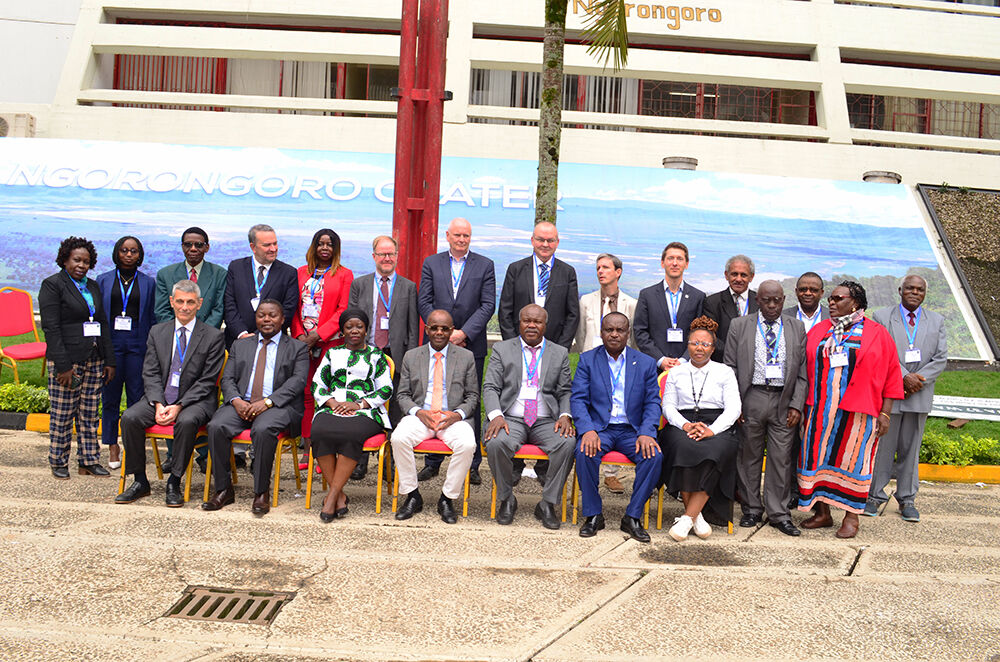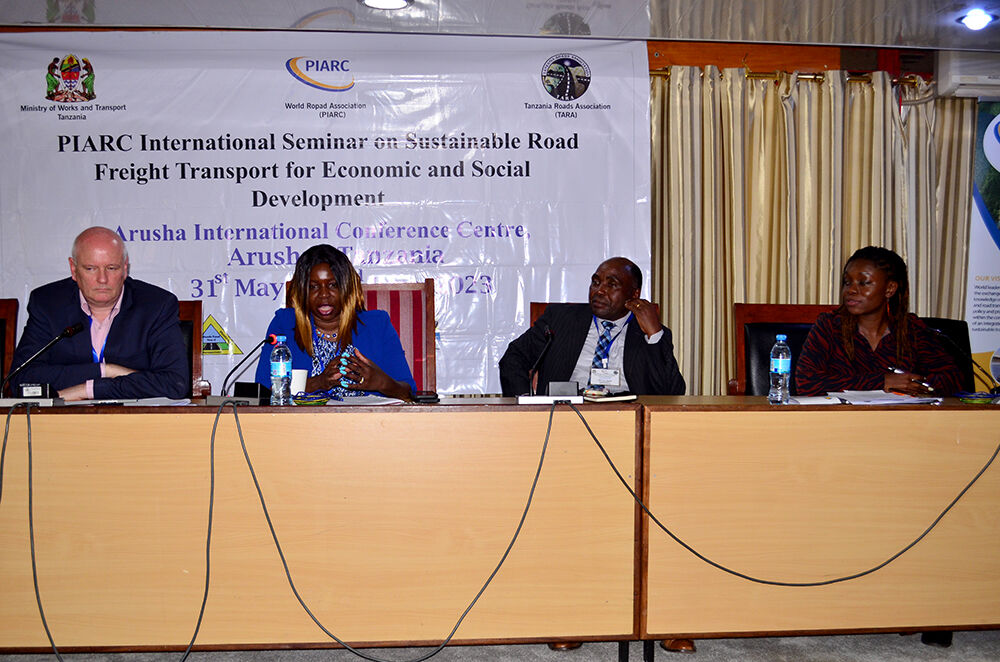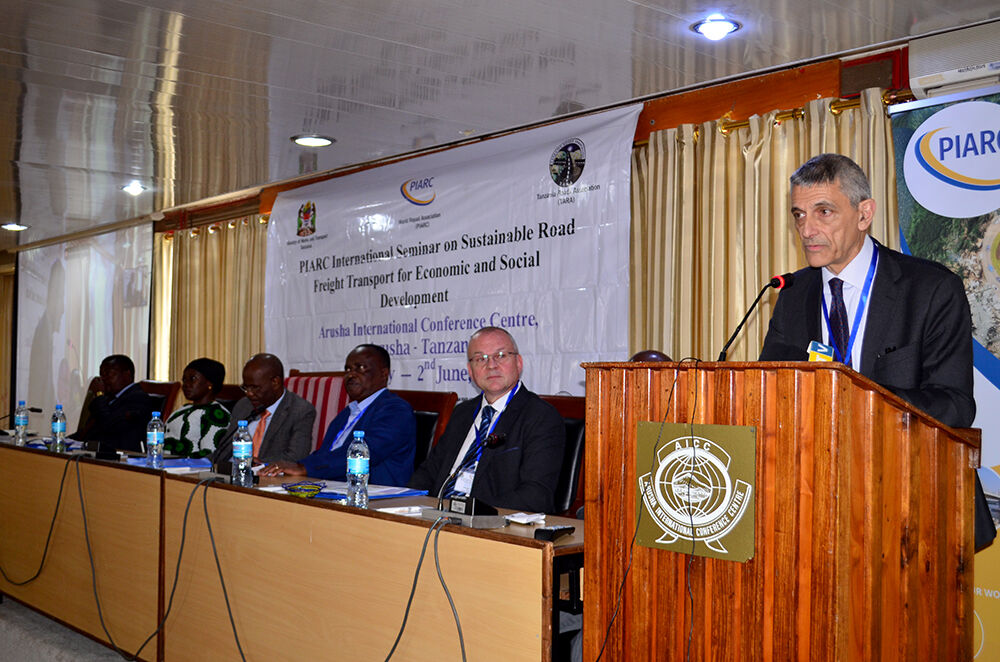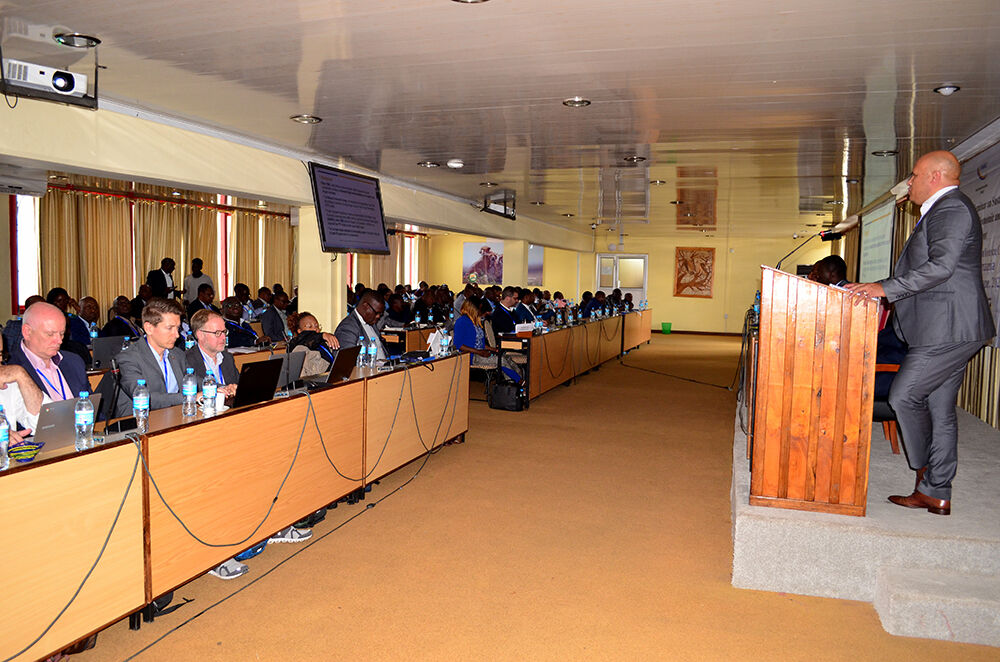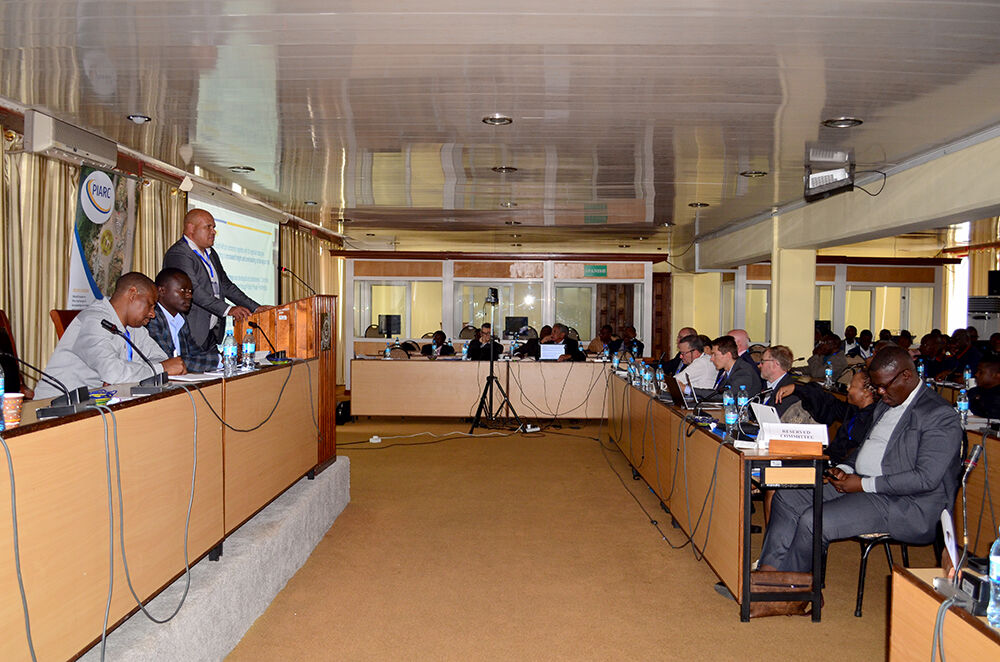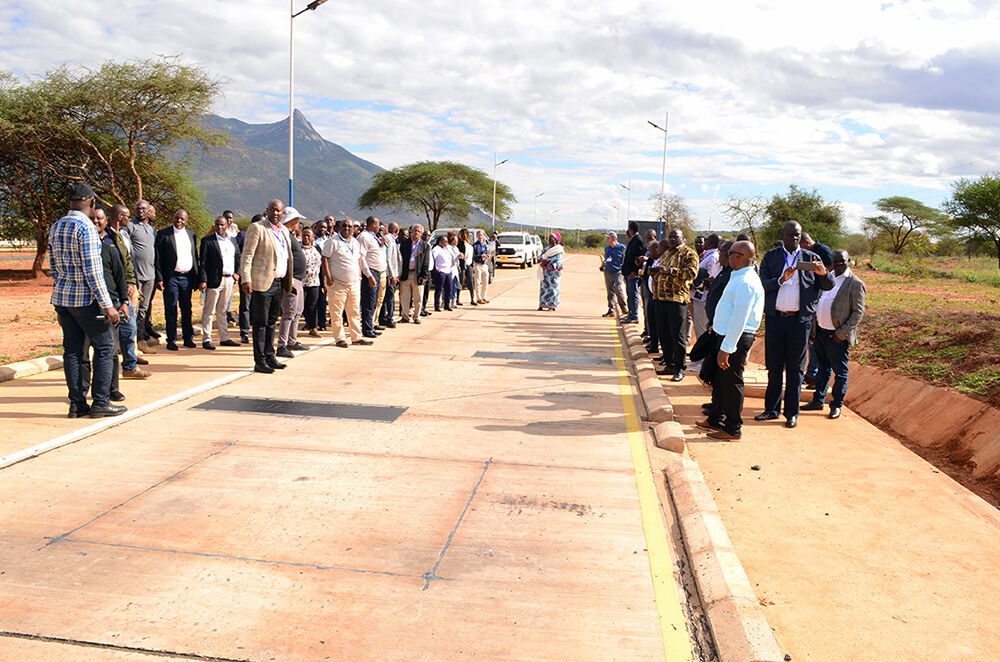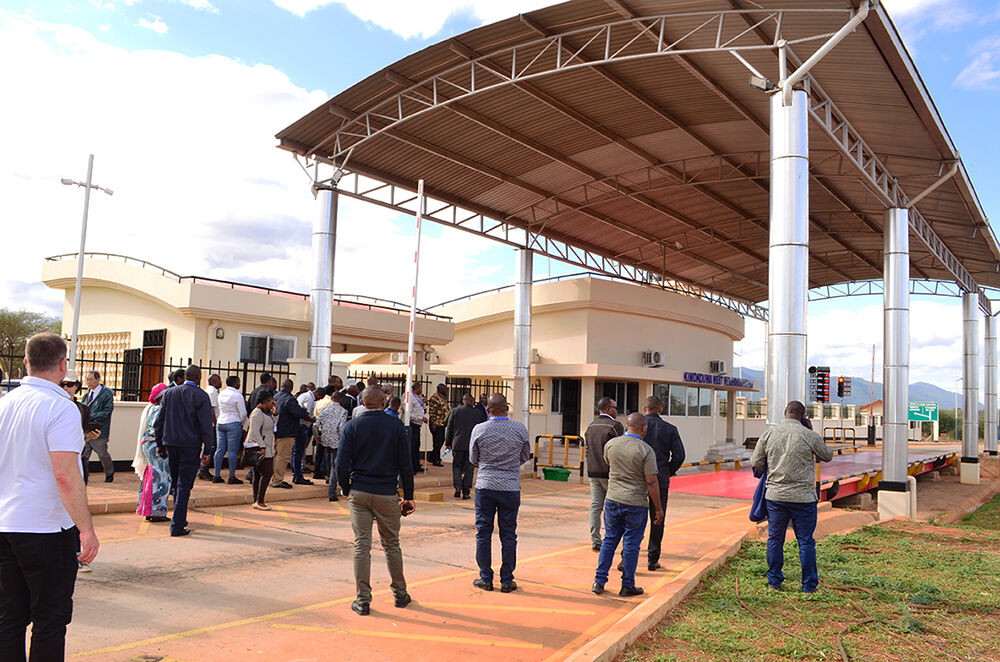International Seminar "Sustainable Road Freight Transport for Economic and Social Development"
31 May - 02 June 2023, Arusha (Tanzania)
The International Seminar, held from May 31st to 02nd June 2023 at Arusha International Conference Centre in Tanzania, was organized jointly by the Technical Committees 1.2 "Planning Road Infrastructure and Transport to Economic and Social Development" and 2.3 "Freight" and the Tanzania Road Association (TARA, PIARC National Committee for Tanzania).
The Tanzania Minister for Works And Transport officiated the opening of the seminar and the Permanent Secretary of same ministry officiated the closing of the seminar.
Preparatory documents for the Seminar
Objectives of the Seminar
The objectives of the seminar were to exchange knowledge and experiences, to present and share good practices and to discuss challenges and newest developments regarding Sustainable Road Freight Transport for economic and social development. The seminar was attended by more than 130 delegates from various countries.
The following topics were covered:
- Economic and social contribution of road freight transport system
- Sustainable mobility plans including freight
- Multimodal freight transport integration
- Freight corridors management and economic development
- Overloading detection and enforcement (including WIM)
- Impact of heavy good vehicles on road infrastructure
- Challenges and opportunities of urban freight
- Truck management and truck parking through ITS
- Approaches for Greening Freight
| International Seminar Proceedings - 31 May - 02 June 2023 Sustainable Road Freight Transport for Economic and Social Development |
|---|
Day 1 - 31 May
Opening session |
|
Session 1 : Economic and Social Contribution of Road Freight Transport System |
|
Session 2 : Sustainable Mobility Plans Including Freight |
|
Round table 1 - Multimodal Freight Transport Integration |
|
Day 2 - 01 June
Session 3 - Freight Corridors Management and Economic Development |
|
Session 4 - Overloading Detection and Enforcement (WIM) |
|
Session 5 - Impact of Heavy Good Vehicles on Road Infrastructure |
|
Round table 2 - Challenges and Opportunities of Urban Freight |
|
Day 3 - 02 June
Session 6 - Truck management and truck parking through ITS |
|
Round table 3 - Approaches for Greening Freight Transport |
|
Closing session |
|
Technical Visit to One Stop Border Post Project and Kimokouwa Weighbridge Project at Namanga, Arusha |
The One Stop Border Post (OSBP) Project whose main objective is to facilitate trade and travel by reducing the number of stops made at a border crossing, thereby reducing the time required for clearance at the border, addressed the issues related to legal and institutional framework, facility and associated procedures that has enabled goods, people and vehicles to stop in a single facility in which they undergo necessary controls following applicable regional and national laws to exit one State and enter the adjoining State, resulting in minimizing routine activities and duplications across border. |
|

Output and Conclusions
Economic and social contribution of road freight transport system
- Roads are very important for economic and social development (back-bone) and their positive contribution to the economic system must be considered in association with their negative impacts
- Roads are part of the multimodal system
- Modal Split Tanzania: 96% Road / 4% Rail (Europe: approx 15% Rail, Switzerland approx 15% Rail) >> there must be a high potential for rail (transit, long distance import/export, bulk, but also consumer goods)
- If Dar es Salaam is further developed as a Gateway to Tanzania and further countries, transit traffic will grow very fast >> Development of railway for freight and improvement of high capacity road are essential , the role of public and private sector needs to be clarified
- Socio-economic CBA valuable for assessment and prioritisation of projects (FI); important for decision making; wider economic impacts also to be considered
- Proactive Freight Transportation Planning recommended (national, state, metropolitan, US/Texas) >> Infrastructures for freight and logistics based on challenges/needs and goals
Sustainable mobility plans including freight
- National Freight Policy with Integration of modes and hubs (multimodality) is key to reach sustainable freight transport (CH, US/TX, …..)
- Freight needs to be stronger integrated in consistent national, state level and regional planning instruments (good experiences CH, BE, AT, US/TX); improved regulation needed for spatial planning and for national measures/incentives
- Improvement of driver quality, vehicle fitness, efficiency at Border Crossings needed (TZA, Inspection, Certification, …)
- More coordination needed between political levels and between transport and spatial development; stakeholder involvement important
- Securing existing and planned freight facilities in sectoral and structure plans
- African countries have very high logistics costs compared to GDP; high potential for intermodal rail identified for African countries, more efficient transport system needed
- On regional/local level positive experiences with SUMP’S (BE)
- Good/better data is needed for fact and evidence based planning and decision making
Multimodal Freight Transport Integration
- Good experiences with Texas multimodal goods movement plan on state level to secure planning, access, connectivity, funding, integrated organisation helps (all modes under one roof)
- Growth potential in multi- and intermodal transport, better use of overall transport system, increase sustainability, discrimination free access to transhipment facilities; political support needed
- Important basis is a national/state masterplan, freight plan, logistics plan etc. (detailed analysis, challenges/needs, goals, measures/projects, funding, implementation plans)
- Better manage inter- and multimodal transport chains
- Do not forget pipelines for liquids to relieve the road
- Cooperation between public and private sector recommended; roles of public (enabler, framework conditions) and private sector; consider PPP options to be considered
Freight corridors management and economic development
- Freight corridors are the instrument to boost economy through access to settlements, integration of modes, cooperation, coordination; positive examples from Africa, US, etc.
- Different types of corridors to be considered (functions, etc.)
- Joint agreement at the beginning; continuous monitoring and evaluation needed (TZA)
- Good management of transit is key issue; already remarkable improvements/efficiency gains (TZA)
- Transformation from transport to an economic corridor (TZA)
- Identification of infrastructure investment needs (US/TX, TZA)
- Analysis structure data and flows, stakeholder analysis, network capabilites, economic role of corridor, necessary freight infrastructures, KPI’s, harmonisation and standardisation, etc
- Funding based on economic impact analysis recommended and needed, clear criteria for prioritisation (US/TX); new funding approaches to be considered (MX); consider PPP
- Freight corridors are financed and co-financed by international Development Banks
Overloading detection and enforcement (WIM)
- Enforcement of weight and dimensions key for preventing road damage and increase road safety
- Challenge: Do not punish those who comply with regulation
- Good experiences from various countries with different weighing systems and also WIM (FR, TZ, SA, …..)
- Use of WIM
- Preselection of potentially overloaded vehicles
-Direct enforcement (high requirements for accuracy, in some EU countries) - Data analysis to help targeting controls (to avoid that correct vehicles lose time) and supports overweight automated permitting, and intelligent access, needs also vehicle recognition
- Good experiences with PPP for weigh stations in SA; role of private operator: management, maintenance, operations
- Further development of weighing stations / facilities needed (all countries)
Impact of heavy good vehicles on road infrastructure
- Violation against regulation (dimensions, weight) causes severe damage on the road/bridges and costs, also impacts on maintenance, underdesign causes problems
- For dimensioning of roads accurate data from traffic counts and axle load surveys is necessary, between planning and operation the dimensioning figures can change, review in the planning process needed
- More traffic counts and axle load surveys to improve data, and to improve dimensioning
- Mitigation of large overloads needed to avoid bridge failures: Proposed is an admonition policy; needs only basic and cheap WIM system
- Correlation between truck overloading and road infrastructure damage not well known; better data necessary; More research needed to identify the impacts of overloaded vehicles on roads
- Neighbouring countries with different weight regulations is a challenge; Good experiences with special corridors to harbours and permits for overloaded vehicles (US/TX)
- Supersingle Tyres: first outline during seminar, some reports available, preparation of working paper by TC 2.3 Freight in June/July 2023
Challenges and opportunities of urban freight
- Many (fast increasing) challenges in urban freight/last mile distribution in many cities (incl. local port traffic): congestion, pollution, GHG-emissions, use of space for loading/unloading, traffic safety, high delivery costs, etc.
- Many solutions to improve urban freight: breaking demand peaks, night delivery, positioning of industrial/logistics in land use plans with improved road access, freight bypasses etc.. But which ones are most suitable?
- Sustainable Mobility Plans (SUMP) are recommended (good practices from BE, IT, and other countries); political will/support is an important precondition; such a plan is recommended for Dar es Salaam
- Stakeholder involvement need to have a common view on the real problems, the goals, measures; comprehensive planning process, needs also time (good example Brussels)
- Lack of good data on regional/urban level in many urban areas improve statistics and conduct freight related surveys, use of GPS data? (facts to understand the problem and to see what could be the impacts of measures)
- Many innovations in discussion or implementation: crowd logistics using public transport/paratransit, cargo bikes, pick up stations, Electric vehicles, delivery robots, drones, But which ones have the best improvement potential and are realistic to be implemented
- Also measures for passenger transport can help: car-pooling, mass transit, …
Truck management and truck parking through ITS
- Truck parking is an issue in all the countries because of growing truck movements (Challenges: availability, real time information, capacity, inadequate facilities for truck drivers, ..), increase of safety, avoid illegal parking; fullfill needs of the truck drivers
- Provision by the government (motorways, …) or private entities (logistics yards). Truck parking areas are an essential component of the Freight Corridors.
- Truck Parking Availability System (TZA) based on Video and the information of the parking lot/configuration module, algorithms and database; good experiences during testing, numerous benefits as accuracy of information, efficiency, safety, cost efficient
- Pilot Truck parking management system in US/TX (based on mobile phone app and bluetooth), Analysis of truck parking availability, 50 to 90% utilisation rates, durations up to 140 minutes, also longer up to 600 minutes (overnight) (US/TX)
- Dynamic parking information (test operation); a) using entrance/exit counting, information shared via website, traffic information b) using cameras for vehicle identification, qualification tests
- Special parking methods, with compact parking (test operation); needs managment system to group the trucks regarding departure time, based on trucking needs
- ITS for road freight transport in Africa for more sustainable transport (efficiency, safety, …)
- Intelligent Traffic Management systems (variable speed limits, incident management, real time information, WIM, freeflow tolling system, lane management, parking guidance, …)
Approaches for Greening Freight Transport
- National Plans / Strategies / Programs for greening freight are recommended as a basis
- Developing green corridors is a valuable approach to be further considered (incl. equipment for loading stations)
- Electrification of smaller vehicles is under way in many countries (bikes, cars, vans, etc.), HIC and LMIC. This is crucial in metropolitan areas.
- Retrofitting of vehicles would reduce emissions in short term (KE); also the use of natural gas instead of conventional petrol/diesel would reduce emissions in short term (TZ)
- Modal shift to intermodal rail could help to make freight greener (especially long distance, rail infrastructure improvements necessary, SA)
- Different approaches available, to be further investigated what is suitable realistic for Tanzania

Group of International Seminar participants
